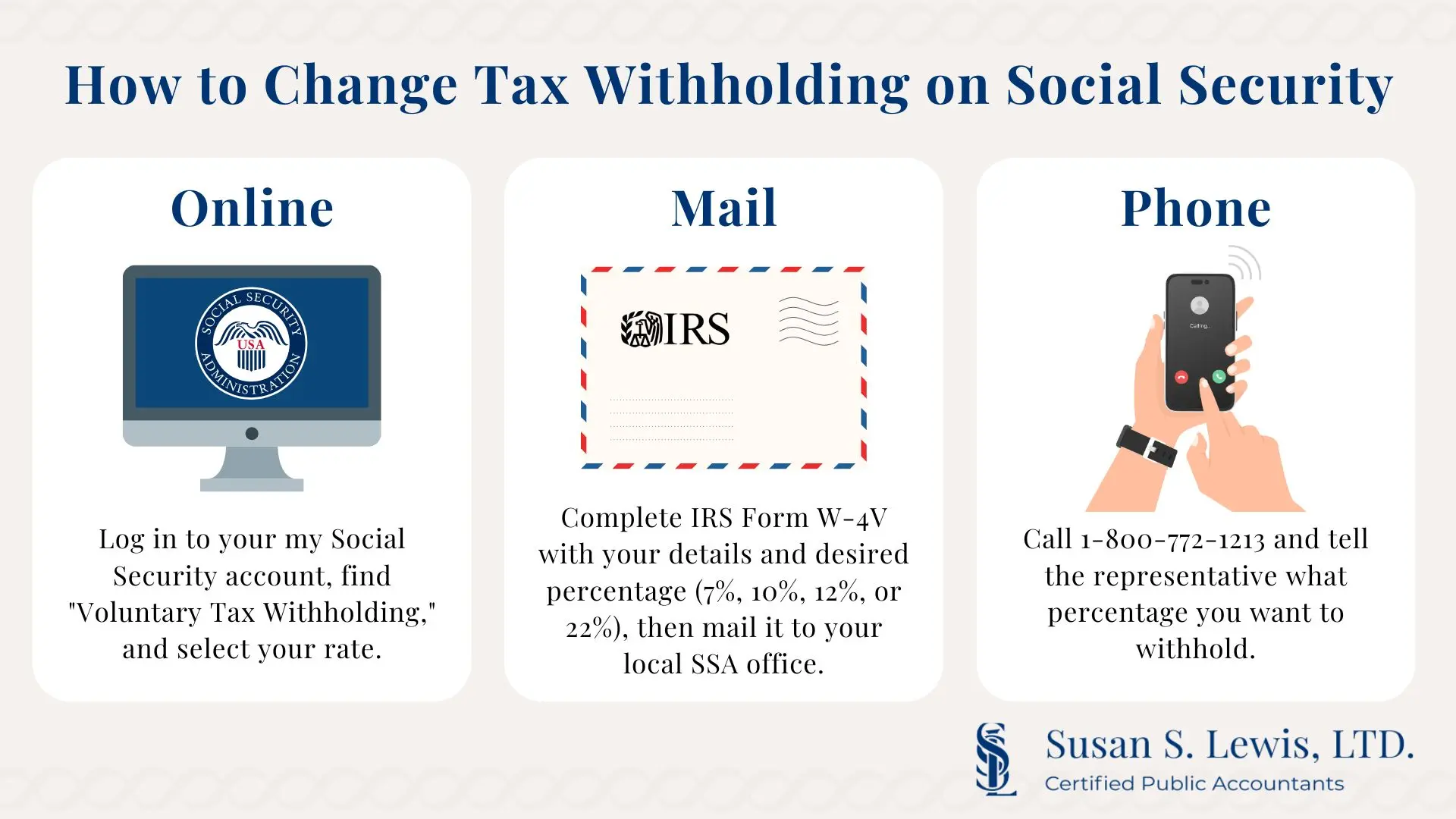Retirement planning can be complex. Managing federal tax withholding on social security payments is a critical component of retirement planning that many beneficiaries overlook. According to the Council of Economic Advisers, 88% of all seniors who receive Social Security will pay no tax on their benefits under recent legislation. However, that still leaves millions of retirees who need to manage tax obligations on their retirement income.
Setting up federal income tax withholding directly from your social security payments helps avoid surprise tax bills and simplifies your retirement planning process. This guide from our experts at Lewis.cpa provides step-by-step instructions for managing your Social Security tax withholding effectively.
When Social Security Benefits Become Subject to Federal Income Tax
Social Security benefits aren't automatically tax-free. The portion of benefits that are taxable depends on the taxpayer's income and filing status, using what's called "combined income" to determine tax liability on your benefits.
Calculating Your Combined Income
Your combined income includes:
- Your adjusted gross income (AGI)
- Tax-exempt interest income
- Half of your Social Security benefits
- Any other earned income, such as wages, pensions, dividends, and capital gains
Federal Income Tax Thresholds for 2025
According to the IRS guidelines, if you file as single and the total comes to more than $25,000, then part of your Social Security benefits may be taxable. Here are the specific thresholds:
Single filers, head of household, or qualifying widow/widower:
- Combined income between $25,000 and $34,000: Up to 50% of benefits may be taxable.
- Combined income above $34,000: Up to 85% of benefits may be taxable.
- If they are married filing jointly, they should take half of their Social Security, plus half of their spouse's Social Security, and add that to all their combined income. If that total is more than $32,000, then part of their Social Security may be taxable.
- Combined income between $32,000 and $44,000: Up to 50% of benefits may be taxable.
- Combined income above $44,000: Up to 85% of benefits may be taxable.
Federal Income Tax Withholding Options
The Social Security Administration explains that when your Social Security benefits are subject to federal taxes, you have two primary options for paying these taxes:
- Make quarterly estimated tax payments directly to the IRS.
- Set up voluntary tax withholding from your monthly Social Security payments.
Many retirees find tax withholding more convenient than managing quarterly estimated tax payments throughout the year.
Available Withholding Rates
According to SSA, you may choose to withhold 7%, 10%, 12%, or 22% of your monthly payment. These predetermined percentages are your only options, and you cannot request custom withholding amounts.
We know what you’re thinking; the withholding percentages may seem unusual, but they're designed to account for the fact that only a portion of your social security benefits may be subject to federal income tax.
How to Set Up Federal Income Tax Withholding: Three Methods

The Social Security Administration offers multiple ways to set up voluntary tax withholding from your benefits.
Method 1: Online Through Your Social Security Account
The most convenient way to manage your federal income tax withholding is through your online account:
- Access your account: You can sign in to or create a personal my Social Security account to check, start, change, or stop your Voluntary Tax Withholding (VTW) request rate online.
- Navigate to tax withholding: Look for the Voluntary Tax Withholding option in your account dashboard.
- Select your rate: Choose from the available percentages (7%, 10%, 12%, or 22%).
- Submit your request: Your changes will typically take effect within 1-2 payment cycles.
Method 2: Using IRS Form W-4V
The IRS Form W-4V allows you to request voluntary withholding from government payments, including Social Security benefits. Form W-4V is not considered valid unless you sign it. Here's how to complete this form:
Step 1: Gather Required Information
- Your full name and current address
- Your Social Security number
- Your claim number (typically your SSN with a suffix letter)
Step 2: Complete the Form
- Lines 1-3: Enter your personal information
- Line 4: Enter your Social Security claim number
- Line 6: Check the box for the withholding percentage you want (7%, 10%, 12%, or 22%)
- Sign and date the form
Step 3: Submit the Form
For withholding on social security benefits, give or send the completed Form W-4V to your local Social Security Administration office. You can:
- Mail it to your local SSA office
- Drop it off in person
- Fax it (if your local office accepts fax submissions)
Method 3: Phone Request
The Social Security Administration provides phone support available in most U.S. time zones Monday through Friday, 8 a.m. to 7 p.m., in English, Spanish, and other languages. Simply tell the representative what percent of your monthly payment you want to withhold for taxes.
Call the Social Security Administration at 1-800-772-1213 to request tax withholding over the phone.

Changing or Stopping Your Tax Withholding
Your tax situation may change over time. In this case, you’ll need to make adjustments to your withholding amount.
To Change Your Withholding Rate
If you want to change your withholding rate, complete a new Form W-4V and give the new form to the payer. You can also make changes through your online Social Security account or by calling the SSA.
To Stop Tax Withholding
If you want to stop withholding, complete a new Form W-4V. After completing lines 1 through 4, check the box on line 7, and sign and date the form. You can also stop withholding through your online account.
When Changes Take Effect
The federal income tax withholding you choose on this form will stay in effect until you change or stop it, or the payments stop. Changes typically take 1-2 payment cycles to process.
Tax Withholding: Strategic Considerations
To plan effectively for retirement, you’ll need to carefully consider your tax withholding strategy to optimize both cash flow and compliance. Here’s what we recommend and Lewis.cpa.
Avoiding Underpayment Penalties
If you expect to owe $1,000 or more in federal income tax when you file your tax return, you're generally required to make quarterly estimated tax payments. Having taxes withheld from Social Security benefits can help retirees avoid a surprise when tax season arrives.
Setting up tax withholding is a simple way to help you avoid underpayment penalties by ensuring you pay taxes throughout the year rather than in one lump sum.
Cash Flow Management
Tax withholding provides a predictable cash flow by spreading your tax obligations across 12 monthly payments, rather than requiring quarterly estimated payments or a large annual payment.
Determining the Right Withholding Rate
Consider these factors when selecting your withholding rate:
- Total expected tax liability: Calculate your expected annual tax bill based on all income sources.
- Other withholding or payments: Account for taxes withheld from pensions, part-time employment, or estimated tax payments.
- Income fluctuations: Consider whether your income varies throughout the year.
Many retirees find that the 10% or 12% withholding rate covers their federal tax obligation on Social Security benefits. However, your situation may require a different approach, which is why it’s always ideal to work with a professional.
Important Timeline and Processing Information

Understanding when and how to submit your withholding requests ensures timely processing and proper tax management.
When to Submit Your Request
You can submit a tax withholding request:
- Before your benefits begin (though some offices may ask you to wait until benefits start)
- At any time after benefits have commenced
- When your tax situation changes
Processing Time
According to the Social Security Administration, this VTW self-help option will help you to have federal taxes withheld timely. This reduces the potential of owing federal taxes at the end of the tax year. Most requests are processed within 1-2 billing cycles.
Annual Review
Review your withholding annually or when your circumstances change. Changes in your income, tax laws, and inflation-adjusted amounts, such as the Social Security COLA, may necessitate withholding changes.
Common Mistakes to Avoid
Let us help you navigate away from common errors to help ensure your tax withholding strategy works effectively from the start.
Starting Benefits Without Considering Taxes
Many retirees apply for social security benefits online without considering tax implications. The online application doesn't include options for setting up tax withholding, leading to unexpected tax bills later.
Choosing the Wrong Withholding Rate
Some retirees estimate their tax liability incorrectly, leading to over-withholding (giving the IRS an interest-free loan) or under-withholding (resulting in tax bills and potential penalties).
Forgetting About State Taxes
Remember that Social Security tax withholding only covers federal obligations. If your state taxes social security benefits, you'll need separate arrangements.
Not Updating Withholding When Circumstances Change
Life events like marriage, divorce, changes in other income sources, or tax law changes may require withholding adjustments.
Alternative Tax Management Strategies
Beyond withholding, you can take several other approaches to manage your Social Security tax obligations effectively.
Estimated Tax Payments

Instead of withholding, you can make quarterly estimated tax payments using Form 1040ES. This approach provides more control over timing and amounts, but requires more active management.
Tax-Efficient Retirement Planning
Consider strategies to minimize taxes on social security benefits:
- Managing retirement account withdrawals
- Using Roth IRA conversions strategically
- Timing of other income sources
Professional Tax Assistance
Taxes in retirement can be complex, especially for retirees with multiple income sources. We recommend staying informed and consulting with a tax professional who can provide personalized advice.
Record Keeping and Tax Reporting
Proper documentation is pivotal to ensuring smooth tax filing. It also helps you track your withholding effectiveness.
Form SSA-1099
The Social Security Administration will report withheld taxes on your annual Form SSA-1099. This form shows:
- Total benefits received
- Federal income tax withheld
- Medicare premiums deducted
Filing Your Tax Return
When filing your federal income tax return:
- Report total social security benefits on the appropriate line
- Calculate the taxable portion using IRS worksheets or tax software
- Claim credit for withheld taxes
Take Control of Your Social Security Tax Withholding
Managing federal income tax withholding on social security payments is a straightforward process that can save you from surprise tax bills and simplify your retirement planning. Whether you choose online management, Form W-4V, or phone requests, the key is acting proactively and reviewing your withholding annually as circumstances change.
We understand that not everyone knows the ins and outs of taxes. Instead of feeling overwhelmed, take action to partner with a team that truly cares about your financial success. At Lewis.cpa, we offer personalized guidance on Social Security tax withholding and comprehensive retirement tax planning. Contact us today to develop a tax strategy that aligns with your retirement goals and ensures compliance with federal tax obligations.






